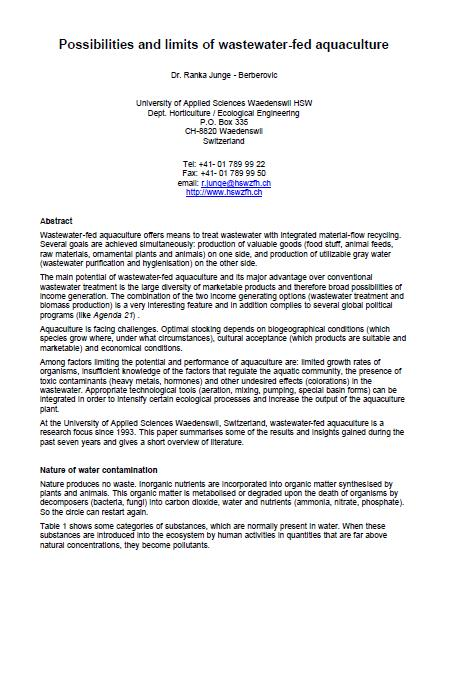
Published in: 2000
Author:
Junge-Berberovic, R.
Uploaded by:
SuSanA secretariat
Partner profile:
common upload
4797 Views
46 Downloads
Content - Summary
Wastewater-fed aquaculture offers means to treat wastewater with integrated material-flow recycling. Several goals are achieved simultaneously: production of valuable goods (food stuff, animal feeds,
raw materials, ornamental plants and animals) on one side, and production of utilizable gray water (wastewater purification and hygienisation) on the other side.
The main potential of wastewater-fed aquaculture and its major advantage over conventional wastewater treatment is the large diversity of marketable products and therefore broad possibilities of income generation. The combination of the two income generating options (wastewater treatment and biomass production) is a very interesting feature and in addition complies to several global political programs (like Agenda 21).
Aquaculture is facing challenges. Optimal stocking depends on biogeographical conditions (which species grow where, under what circumstances), cultural acceptance (which products are suitable and
marketable) and economical conditions.
Among factors limiting the potential and performance of aquaculture are: limited growth rates of organisms, insufficient knowledge of the factors that regulate the aquatic community, the presence of toxic contaminants (heavy metals, hormones) and other undesired effects (colorations) in the
wastewater. Appropriate technological tools (aeration, mixing, pumping, special basin forms) can be integrated in order to intensify certain ecological processes and increase the output of the aquaculture
plant.
At the University of Applied Sciences Waedenswil, Switzerland, wastewater-fed aquaculture is a research focus since 1993. This paper summarises some of the results and insights gained during the past seven years and gives a short overview of literature.
Additional information
Presented at the "International Symposium Ecological Sanitation 'Ecosan - Closing the Loop in Wastewater Management and Sanitation'", October 30-31, 2000, Bonn/Germany
Bibliographic information
Junge-Berberovic, R. (2000). Possibilities and limits of wastewater-fed aquaculture.
Filter tags
English















